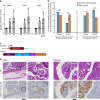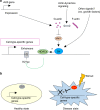Srf destabilizes cellular identity by suppressing cell-type-specific gene expression programs
- PMID: 29643333
- PMCID: PMC5895821
- DOI: 10.1038/s41467-018-03748-1
Srf destabilizes cellular identity by suppressing cell-type-specific gene expression programs
Abstract
Multicellular organisms consist of multiple cell types. The identity of these cells is primarily maintained by cell-type-specific gene expression programs; however, mechanisms that suppress these programs are poorly defined. Here we show that serum response factor (Srf), a transcription factor that is activated by various extracellular stimuli, can repress cell-type-specific genes and promote cellular reprogramming to pluripotency. Manipulations that decrease β-actin monomer quantity result in the nuclear accumulation of Mkl1 and the activation of Srf, which downregulate cell-type-specific genes and alter the epigenetics of regulatory regions and chromatin organization. Mice overexpressing Srf exhibit various pathologies including an ulcerative colitis-like symptom and a metaplasia-like phenotype in the pancreas. Our results demonstrate an unexpected function of Srf via a mechanism by which extracellular stimuli actively destabilize cell identity and suggest Srf involvement in a wide range of diseases.
Conflict of interest statement
The authors declare no competing interests.
Figures







Similar articles
-
Filamin A interacts with the coactivator MKL1 to promote the activity of the transcription factor SRF and cell migration.Sci Signal. 2015 Nov 10;8(402):ra112. doi: 10.1126/scisignal.aad2959. Sci Signal. 2015. PMID: 26554816
-
Suppression of the ERK-SRF axis facilitates somatic cell reprogramming.Exp Mol Med. 2018 Feb 23;50(2):e448. doi: 10.1038/emm.2017.279. Exp Mol Med. 2018. PMID: 29472703 Free PMC article.
-
Ablation of serum response factor in hepatic stellate cells attenuates liver fibrosis.J Mol Med (Berl). 2019 Nov;97(11):1521-1533. doi: 10.1007/s00109-019-01831-8. Epub 2019 Aug 21. J Mol Med (Berl). 2019. PMID: 31435710
-
Myocardin/MKL family of SRF coactivators: key regulators of immediate early and muscle specific gene expression.J Cell Biochem. 2004 Sep 1;93(1):74-82. doi: 10.1002/jcb.20199. J Cell Biochem. 2004. PMID: 15352164 Review.
-
Molecular Mechanisms of Leukocyte Migration and Its Potential Targeting-Lessons Learned From MKL1/SRF-Related Primary Immunodeficiency Diseases.Front Immunol. 2021 Feb 22;12:615477. doi: 10.3389/fimmu.2021.615477. eCollection 2021. Front Immunol. 2021. PMID: 33692789 Free PMC article. Review.
Cited by
-
Synergistic activation of genes promoting invasiveness by dual deprivation in oxygen and nutrients.Int J Exp Pathol. 2023 Apr;104(2):64-75. doi: 10.1111/iep.12464. Epub 2023 Jan 24. Int J Exp Pathol. 2023. PMID: 36694990 Free PMC article.
-
Relieving DYRK1A repression of MKL1 confers an adult-like phenotype to human infantile megakaryocytes.J Clin Invest. 2022 Oct 3;132(19):e154839. doi: 10.1172/JCI154839. J Clin Invest. 2022. PMID: 35925681 Free PMC article.
-
Biphasic regulation of epigenetic state by matrix stiffness during cell reprogramming.Sci Adv. 2024 Feb 16;10(7):eadk0639. doi: 10.1126/sciadv.adk0639. Epub 2024 Feb 14. Sci Adv. 2024. PMID: 38354231 Free PMC article.
-
Serum Response Factor Reduces Gene Expression Noise and Confers Cell State Stability.Stem Cells. 2023 Oct 8;41(10):907-915. doi: 10.1093/stmcls/sxad051. Stem Cells. 2023. PMID: 37386941 Free PMC article.
-
Epigenetic plasticity safeguards heterochromatin configuration in mammals.Nucleic Acids Res. 2023 Jul 7;51(12):6190-6207. doi: 10.1093/nar/gkad387. Nucleic Acids Res. 2023. PMID: 37178005 Free PMC article.
References
Publication types
MeSH terms
Substances
LinkOut - more resources
Full Text Sources
Other Literature Sources
Medical
Molecular Biology Databases
Miscellaneous

